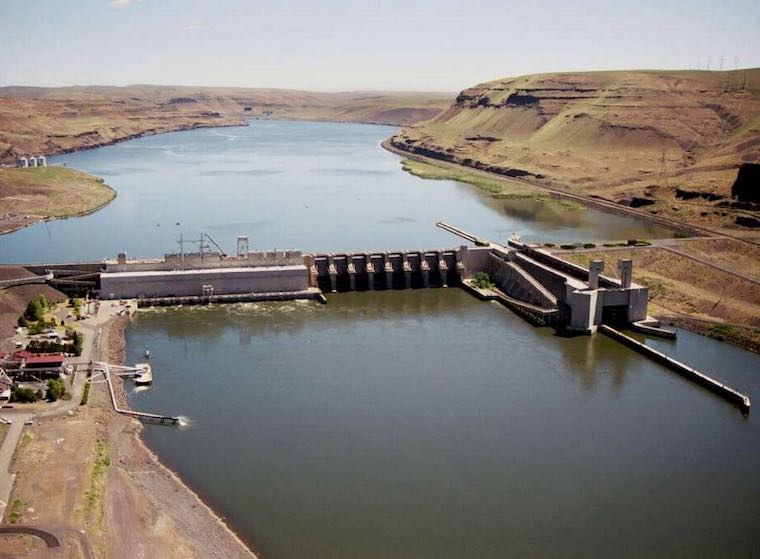forum
library
tutorial
contact

To Protect the Grid and Meet Climate Goals,
We Need the Lower Snake River Dams
by Kirk Hudson, Rich Wallen & Gary Ivory
Quad City Herald, July 13, 2022
|
the film forum library tutorial contact |

|
To Protect the Grid and Meet Climate Goals,
by Kirk Hudson, Rich Wallen & Gary Ivory
|
The draft report lacks independent engineering,
cost-benefit and fish-benefit analysis.
 The headlines in recent weeks have been startling: Extreme heat and energy shortfalls in much of the country could lead to power outages this summer across the Midwest, Texas and California, and another active wildfire season in the West will pose even more reliability risks for the power system.
The headlines in recent weeks have been startling: Extreme heat and energy shortfalls in much of the country could lead to power outages this summer across the Midwest, Texas and California, and another active wildfire season in the West will pose even more reliability risks for the power system.
The nation's power grid is under incredible pressure. Growing electricity demand, climate change and carbon-reduction policies are increasing the risk of blackouts. As states phase out fossil fuels, the Northwest Power and Conservation Council reports that at least 3,500 additional megawatts of renewable resources are needed by 2027 to meet the region's energy needs and reduce emissions.
Despite all this, U.S. Senator Patty Murray and Governor Jay Inslee recently released a draft report which suggests a willingness to remove a critical source of carbon-free energy from the power grid.
The draft Murray-Inslee report examines the potential impacts of breaching four hydroelectric dams on the Lower Snake River and suggests the dams' energy generation could be replaced by alternative technologies.
We strongly disagree. We believe this conclusion was based on questionable baseline assumptions and does not adequately address future challenges associated with plans to retire fossil fuel generation in the West.
The draft report lacks independent engineering, cost-benefit and fish-benefit analysis. As public utility districts that own and operate five dams on the Columbia River, all of which meet or exceed every federal and state standard to protect salmon, we do not want this deeply flawed draft report used to make decisions about the future of hydropower -- decisions that could cost billions of taxpayer dollars, increase power rates, have negligible benefits, and further strain the electricity grid.
The Lower Snake River dams are significant sources of carbon-free electricity for the northwest. They provide 1,000 megawatts of energy, and up to 3,033 megawatts of capacity. That's enough energy to power a city the size of Seattle.
Here in North Central Washington, our customer-owned utilities produce reliable, carbon-free hydropower, which, like the power from the Lower Snake River dams, is used to balance the grid and fill in the gaps inherent with wind and solar. Our dams operate within the same power system as those on the Lower Snake River.
That system has worked as designed during the extreme weather events of recent years, keeping the lights on and protecting the health and safety of vulnerable populations. According to the Bonneville Power Administration, the Lower Snake River dams played an important role during last year's deep freeze and heat dome events. Removing the dams would put the region at a very high risk of blackouts during these types of weather events.
Simply put: There are no commercially available technologies that can be deployed at the scale necessary to replace the clean, renewable energy and capacity provided by hydropower. Technologies such as batteries have limited ability to back up wind and solar for short periods of time -- generally for one to four hours. But for storage to provide reliable capacity during extreme weather events, when wind and solar are not generating, it must have a fleetwide duration of 100-1000 hours.
We recognize Sen. Murray and Gov. Inslee's long-standing efforts to achieve progress on the big issues of salmon recovery and clean energy. In our role as hydropower operators, we stand ready to support the pursuit of a carbon-free grid that electrifies transportation, buildings, appliances, and many other sectors. But it is counterproductive to frustrate these goals by removing hydropower capacity.
It is essential that policymakers fully understand the vital role the Lower Snake River dams play in meeting the region's energy supply needs and carbon reduction goals. We hope they consider that removing the dams could have public safety, electric reliability, and cost consequences for millions of people across the Northwest.
learn more on topics covered in the film
see the video
read the script
learn the songs
discussion forum
